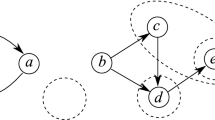Abstract
Trace monoids are obtained from free monoids by defining a subsetI of pairs of letters that are allowed to commute. Most of the work of this theory is an attempt to relate the properties of these monoids to the properties ofI. Following the work initiated by Büchi we show that when the reflexive closure ofI is transitive (the trace monoid is then a free product of free commutative monoids) it is possible to define a second-order logic whose models are the traces viewed as dependence graphs and which characterizes exactly the sets of traces that are rational. This logic essentially utilizes a predicate based on the partial ordering defined by the dependence graph and a predicate related to a restricted use of the comparison of cardinality.
Similar content being viewed by others
References
IJ. J. Aalbersberg and H. J. Hoogeboom. Characterizations of the Decidability of Some Problems for Regular Trace Languages.Math. Systems Theory, 20:1–19, 1989.
IJ. J. Aalsbersberg and G. Rozenberg. Theory of Traces.Theoret. Comput. Sci., 60:1–82, 1988.
IJ. J. Aalbersberg and E. Welz. Trace Languages Defined by Regular String Languages.RAIRO Inform. Théor. Appl., 20:103–119, 1986.
J. Berstel.Transductions and Context-Free Languages. Teubner, 1979.
A. Bertoni, G. Mauri, and N. Sabadini. Unambiguous Regular Trace Languages. In G. Katona, J. Demetrovics, and A. Salomaa, editors,Algebra, Combinatorics and Logic p. 249–260. Colloquia Mathematica Societatis János Bolyai, vol. 42. North-Holland, Amsterdam, 1985.
J. R. Büchi. Weak Second-Order Logic and Finite Automata.Z. Math. Logik Grundlag. Math., 6:66–92, 1960.
S. Eilenberg.Automata, Languages and Machines, vol. A. Academic Press, New York, 1974.
C. C. Elgot. Decision Problems of Finite Automata Design and Related Arithmetics.Trans. Amer. Math. Soc., 19:21–52, 1961.
S. Ginsburg and E. H. Spanier. Semigroups, Presburger Formulas, and Languages.Pacific J. Math., 16:285–296, 1966.
J. D. MacKnight, Jr., and A. J. Storey. Equidivisible Semigroups.J. Algebra, 12:24–48, 1969.
R. McNaughton and S. Papert.Counter-Free Automata. MIT Press, Cambridge, MA, 1971.
M. Parigot and E. Pelz. A Logical Approach of Petri Net Languages.Theoret. Comput. Sci., 39:155–169, 1985.
D. Perrin and J.-E. Pin. First-Order Logic and Star-Free Sets.J. Comput. System Sci., 32:393–406, 1986.
J. Sakarovitch. On Regular Trace Languages.Theoret. Comput. Sci., 52:59–75, 1987.
W. Thomas. Classifying Regular Events in Symbolic Logic.J. Comput. System Sci., 25:360–376, 1982.
W. Thomas. On Logical Definability of Trace Languages. InProceedings of the Workshop of the ASMICS Group, Kochel am See. North-Holland, Amsterdam, 1990.
Author information
Authors and Affiliations
Additional information
This research was supported by the PRC Mathématiques et Informatique.
Rights and permissions
About this article
Cite this article
Choffrut, C., Guerra, L. Logical definability of some rational trace languages. Math. Systems Theory 28, 397–420 (1995). https://doi.org/10.1007/BF01185864
Received:
Revised:
Accepted:
Issue Date:
DOI: https://doi.org/10.1007/BF01185864




